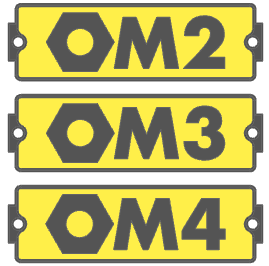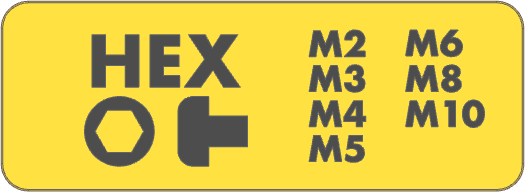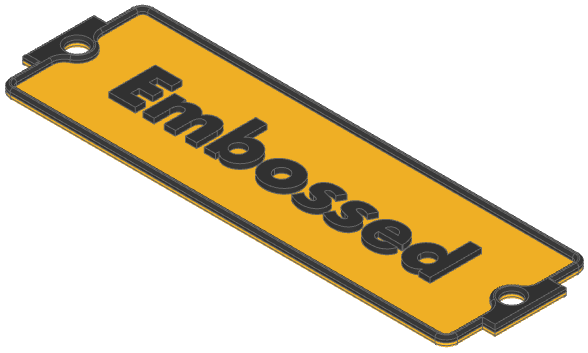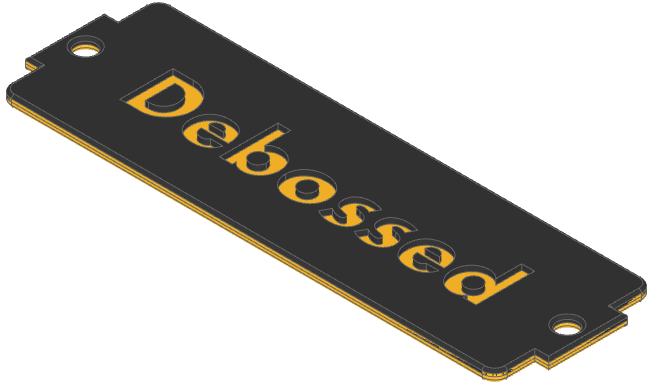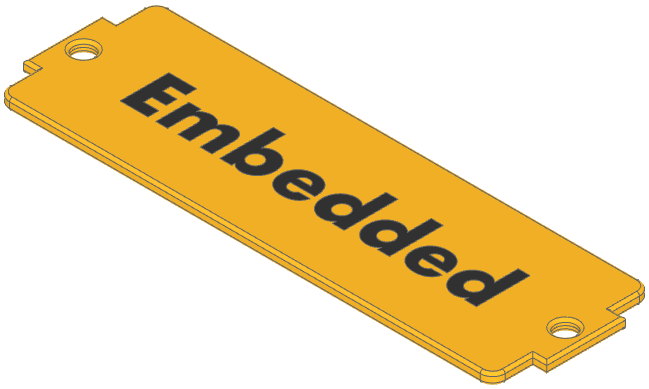Generates 3d printable labels for labelled gridfinity bins (primarily pred and Cullen J Webb labels), and similar generate-smallish-printable-label uses. Leverages build123d.
This is an early version of a hobby project. Thus:
- It has a lot of rough edges, not the least that the output is messy and not very useful. But functionality not used much might not work well.
- It sometimes needs manual encouragement to make labels looking good or consistent.
- A habit of sometimes crashing OCP when geometry is a little bit odd.
You should be able to install into your favorite python-virtual-environment manager by just using pip:
pip install gflabel
This should work on most modern platforms, but with the following caveats:
- Linux wheels for the dependency cadquery-ocp are only available on resonably modern (e.g. Ubuntu 22.4+) linux distributions, so you may have to go to conda to install on an older machine.
- For specifically macOS arm64, the underlying cadquery-ocp library is not available as a wheel through pypi. In this case, you will have to set up the build123d environment manually. build123d has some notes on resolving this conflict.
Otherwise, you can check out this repository and pip install it directly, or
install directly from the github repo:
pip install git+https://github.com/ndevenish/gflabel.git
If you are using VSCode with the vscode-ocp-cad-viewer extension,
you can add the --vscode flag when running gflabel, and the label should
show up as a preview. This saves opening the output CAD files in a slicer or
other viewer, and is useful when prototyping labels.
By default, labels are written to an output file "label.step". You can change
this with -o FILENAME. .step, .stl and .svg are recognised
A simple, single label generation on a pred-style base:
gflabel "Basic Label" -o basic.step
Symbols are specified with { curly braces }. If you specify more labels
than divisions (which defaults to one), then multiple labels will be generated
with a single call:
gflabel "{nut}M2" "{nut}M3" "{nut}M4"
Or, if you specify divisions, then you can generate a multi-bin label (in this example, a margin is also added to ensure that the labels are not too dense):
gflabel --width 2 --divisions=3 "{nut}M2" "{nut}M3" "{nut}M4" --vscode --margin=2
You can span multiple lines, mix text and symbols, and some symbols can be passed configuration (e.g. in this case the bolt length is dynamically specified as 20mm):
gflabel "{head(hex)} {bolt(20)}\nM2×20"
Some symbols can also take many modifiers for e.g. drive or head type:
gflabel "{head(+)} {bolt(50,slotted,round)}\nM3×50"
And multiple label styles/symbol styles/fonts can be selected:
gflabel --base=webb --font=Arial "M3×20{...}{webbolt(+)}"
Here's a more complex example, generating a Pred Gridfinity Storage Box label. This uses multiple proportioned columns, symbols, and alignment:
gflabel --base=predbox -w 5 "HEX\n{head(hex)} {bolt(5)}{3|}{<}M2\nM3\nM4\nM5{2|2}{<}M6\nM8\nM10\n"
The full command parameter usage (as generate by gflabel --help):
usage: gflabel [-h] [--base {pred,plain,none,webb,predbox}] [--vscode] [-w WIDTH]
[--height HEIGHT] [--depth DEPTH_MM] [--no-overheight] [-d DIVISIONS]
[--font FONT]
[--font-size-maximum FONT_SIZE_MAXIMUM | --font-size FONT_SIZE]
[--font-style {regular,bold,italic}] [--margin MARGIN]
[-o [OUTPUT ...]] [--style {embossed,debossed,embedded}]
[--list-fragments] [--list-symbols] [--label-gap LABEL_GAP]
[--column-gap COLUMN_GAP] [-v]
LABEL [LABEL ...]
Generate gridfinity bin labels
positional arguments:
LABEL
options:
-h, --help show this help message and exit
--base {pred,plain,none,webb,predbox}
Label base to generate onto. [Default: pred]
--vscode Run in vscode_ocp mode, and show the label afterwards.
-w WIDTH, --width WIDTH
Label width. If using a gridfinity standard base, then this is
width in U. Otherwise, width in mm.
--height HEIGHT Label height, in mm. Ignored for standardised label bases.
--depth DEPTH_MM How high (or deep) the label extrusion is.
--no-overheight Disable the 'Overheight' system. This allows some symbols to
oversize, meaning that the rest of the line will first shrink
before they are shrunk.
-d DIVISIONS, --divisions DIVISIONS
How many areas to divide a single label into. If more labels
that this are requested, multiple labels will be generated.
Default: 1.
--font FONT The font to use for rendering. [Default: Futura]
--font-size-maximum FONT_SIZE_MAXIMUM
Specify a maximum font size (in mm) to use for rendering. The
text may end up smaller than this if it needs to fit in the
area.
--font-size FONT_SIZE
The font size (in mm) to use for rendering. If unset, then the
font will use as much vertical space as needed (that also fits
within the horizontal area).
--font-style {regular,bold,italic}
The font style use for rendering. [Default: regular]
--margin MARGIN The margin area (in mm) to leave around the label contents.
Default is per-base.
-o [OUTPUT ...], --output [OUTPUT ...]
Output filename(s). [Default: ['label.step']]
--style {embossed,debossed,embedded}
How the label contents are formed.
--list-fragments List all available fragments.
--list-symbols List all available electronic symbols
--label-gap LABEL_GAP
Vertical gap (in mm) between physical labels. Default: 2 mm
--column-gap COLUMN_GAP
Gap (in mm) between columns
-v, --verbose Verbose output
Labels can consist of:
- A physical base, which is the object that the labels are extruded out of (or cut into).
- A label style, which specifies whether the label is raised out of, cut into, or flush with the surface of the base.
- Regular text, including unicode symbols (although complex symbols like emoji are unlikely to render properly, or at all - this is down to the underlying library).
- Newlines, either explicitly typed in (e.g. at the terminal), or escaped by
writing
\nin the label definition. Each line will be rendered separately, but still constrained to the same label area. - Fragments. These are directives enclosed in
{curly}braces that add symbols or define an area on the label.
Let's go through each of these:
The base (specified by --base=TYPE) defines the shape of what the label is generated on top of. Currently, the following bases are understood:
| Base | Description | Image |
|---|---|---|
pred |
For Pred's parametric labelled bins labels. If specifying this style, then height is ignored and width is in gridfinity units (e.g. --width=1 for a label for a single 42mm bin). |
 |
predbox |
For labels matching the style of Pred's Parametric Storage Box. These are larger (~25 mm) labels for slotting in the front of the parametric storage boxes. --width is for the storage bin width, and is 4, 5, 6, or 7 u. |
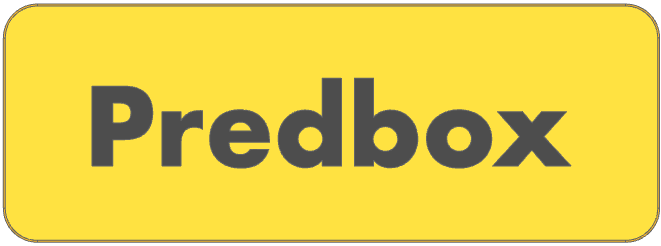 |
plain |
For a blank, square label with a chamfered top edge. The specified width and height will be the whole area of the label base. You must specify at least a width. |  |
webb |
For Cullen J Webb's swappable label system. Label is a 36.4 mm x 11 mm rounded rectangle with snap-fit inserts on the back. Use without margins to match the author's style labels. |  |
none |
For no base at all - the label will still be extruded. This is useful if you want to generate a label model to place onto another volume in the slicer. |  |
Label style controls whether the generated label is raised out of, cut into, or
flush with the base surface. This is controlled with the --style= parameter,
which can be set to embossed, debossed, or embedded:
Text is rendered as text on the label, including variable width whitespaces so e.g. a halfspace will render a halfspace width, which is good for minor separation if you don't want a gap of specific width.
GFLabel comes with Open Sans, and will use this (in regular, bold or italic) if you don't otherwise specify any font preference.
Options for controlling font rendering are:
| Setting | Description |
|---|---|
--font NAME |
Specified font directly, by name. This will have to be a font that is generally installed and available on your system. If you don't specify this (or -path), then a packaged version of Open Sans will be used. |
--font-path /path/to/font |
Specify font by directly specifying the location of the font file on disk. Takes precedence over --font, so if you specify both, this will be used. |
--font-style STYLE |
Where STYLE can be bolt, italic, or regular (the default). If you haven't specified a font file then the underlying font system will make a best-effort attempt to find your selected font in one of these weights. |
--font-size NUMBER |
Specifies a fixed height (in mm) for the font on the label. Text will always be rendered at this size, even if it causes the text to not fit. Using this can help text-size consistency over many labels, as otherwise the shorter text labels may end up at a larger scale (because they can fill the vertical without over-running it's available space). |
--font-size-maximum NUMBER |
Specifies a maximum font size. Text won't be allowed to go larger than this, but text can be shrunk to fit if it would otherwise overrun it's label area. This can help text-size disparity over many labels in cases where some of them are much longer, and you can tolerate them being shrunken. This is used to generate the electrical symbol examples. |
Along with text, you can add symbols and features to a label by specifying
"fragments". These are directives enclosed in {curly braces}.
A list of all the fragments currently recognised:
| Names | Description |
|---|---|
| ... | Blank area that always expands to fill available space. If specified multiple times, the areas will be balanced between entries. This can be used to justify/align text. |
| 1, 4.2, ... | A gap of specific width, in mm. |
| <, > | Only used at the start of a single label or column. Specifies that all lines in the area should be left or right aligned. Invalid when specified elsewhere. |
| bolt | Variable length bolt, in the style of Printables pred-box labels. If the requested bolt is longer than the available space, then the bolt will be as large as possible with a broken thread. |
| box | Arbitrary width, height centered box. If height is not specified, will expand to row height. |
| head | Screw head with specifiable head-shape. |
| hexhead | Hexagonal screw head. Will accept drives, but not compulsory. |
| hexnut, nut | Hexagonal outer profile nut with circular cutout. |
| lockwasher | Circular washer with a locking cutout. |
| magnet | Horseshoe shaped magnet symbol. |
| measure | Fills as much area as possible with a dimension line, and shows the length. Useful for debugging. |
| sym, symbol | Render an electronic symbol. |
| threaded_insert | Representation of a threaded insert. |
| variable_resistor | Electrical symbol of a variable resistor. |
| washer | Circular washer with a circular hole. |
| webbolt | Alternate bolt representation incorporating screw drive, with fixed length. |
| (pipe) |
Denotes a column edge, where the label should be split. You can specify relative proportions for the columns, as well as specifying the column alignment. |
A basic set of examples showing the usage of some of these:
The {head(...)} fragment, and any other fragments that will accept drive
head types, takes a feature specification for the kind of drive that you want
to represent. These are stackable, so you can specify multiple drives and they
will be overlapped. Examples of using the drive types are:
There are two classes of bolt/screw representation:
boltcorresponding to the Pred's printable label bin bolt style. This is used simple as{bolt(LENGTH)}, whereLENGTHis the length of the bolt/ screw stem that you want (excluding the height of the head). If the label area is too small to fit the entire bolt on, then the bolt will be rendered with a "break" in the middle, indicating that it does not show the whole bolt length. It will also accept aslotfeature that marks a small indent on the top of the head, andflangedin order to render a washer-style flange at the bottom of the active head.webbcorresponding to the bolt style included with Cullen J Webb's swappable gridfinity label system. It doesn't change length, but it will accept any combination of screw drive specifier and display them in the bolt head.
Both types of bolts will accept a head style, one of pan, socket, round,
or countersunk. Both can be marked as tapping to have a pointed tip, and
both can be pointed backwards by adding the flipped feature.
Examples showing some differences between the two bolts:
Although the division system (--divisions) can be used to create a single
label with multiple areas (e.g. the intended usage is for labels for a divided
gridfinity bin that has e.g. more bins than gridfinity units), it isn't as
flexible as the column separator fragment, {|} (using the pipe symbol).
In the simple case, this just separates the areas mostly the same as if you had
divided the bin, except that column mode has an explicit (and default) column
gap (controled by --column-gap). Here's a label split into three with
divisions (left), and columns(right):
$ gflabel "A\n{measure}" "B\n{measure}" "C\n{measure}"
$ gflabel "A\n{measure}{|}B\n{measure}{|}C\n{measure}"
Note
{measure} fragments have been added to make it easy to see how the layout
is being affected.
However, with columns you can specify the proportions each column should be in
relation to each other, by specifying the proportion each side of the pipe e.g.
{2|1}. If unspecified, then the column is assumed to be proportion 1 compared
to whatever the other side is.
In this example, we've asked for 4:1:2 scaling:
$ gflabel "A\n{measure}{4|}B\n{measure}{1|2}C\n{measure}"
And here, we're combining the column fragments with the alignment fragment. Alignment markers can go at the start of any column:
gflabel "{<}A\n{measure}{4|}{>}B\n{measure}{1|2}{<}C\n{measure}"
Electronic symbols can be generated using the {symbol(...)} fragment.
GFLabel is using the Chris Pikul Electronic Symbols library kindly
released under MIT License.
There are currently three main approaches to selecting the symbol that you want:
- Exact ID, or exact Filename, as defined the original source.
- Component name, as listed on the symbol source README (and in the
table below). In cases where multiple symbols have the same name, they can
be differentiated by standard e.g.
{symbol(capacitor,iec)}. If standard is not specified, and there are multiple matches, then the first of [common,iec,ieee] will be chosen (if doing so makes it unambiguous). - Fuzzy matching. You can pass in words or parts of words. Symbols with category, name or ID that match these (in any order) will be selected. If more than one candidate symbols matches, then the table of possible matches will be returned so that you can refine it further.
You can list all of the symbols available with gflabel --list-symbols.
For an example of this fuzzy matching, the fragment {symbol(ground)} isn't
enough to disambiguate between the possible options, so the table of matches
is printed to help you refine the definition:
$ gflabel '{symbol(ground)}'
...
Could not decide on symbol from fuzzy specification "ground". Possible options:
ID Category Name Standard Filename
ground-com-signal GROUND Digital/Signal Ground COMMON Ground-COM-Signal
ground-com-general GROUND Common/Earth Ground COMMON Ground-COM-General
ground-com-chassis GROUND Chassis Ground COMMON Ground-COM-Chassis
Could not proceed: Please specify symbol more precisely.
Given this, you could disambiguate by refining the fuzzy specification e.g.
{symbol(signal ground)}, matching the exact name {symbol(Common/Earth Ground)},
or specifying the ID/Filename exactly: {symbol(Ground-COM-Signal)}.
Here is a table of all symbols, rendered by GFLabel, with their name as per the source symbol library. Note that for some of the symbols, they are rendered incorrectly. This is an unresolved bug in GFLabel.
GFLabel uses (and bundles) a couple of dependencies in subdirectories:
- The Chris Pikul Electronic Symbols library, MIT License © 2022 Chris Pikul.
- The Open Sans font family, OFL-1.1 License © 2020 The Open Sans Project Authors.

